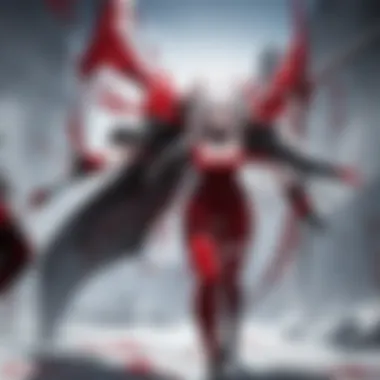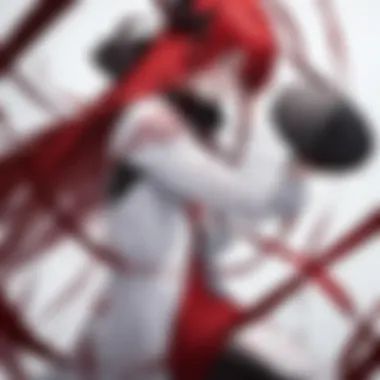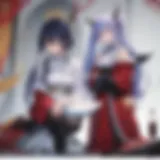A Deep Dive into the Blood+ Anime Series


Intro
The 'Blood+' series stands out as a compelling entry in the landscape of anime. It weaves together elements of horror, drama, and action, capturing the audience's attention through its complex narrative and multifaceted characters. This series is not merely an adaptation of the popular film 'Blood: The Last Vampire'; it expands upon the original mythology, offering new themes and layers to explore.
In this article, we will analyze the series in detail. We will begin with a thorough review of its episodes, then delve into character spotlights that highlight key figures and their journeys. Next, we’ll compare the anime to its manga counterpart to understand the unique strengths of each medium. Industry insights will also be discussed, touching on broader trends and upcoming releases. Finally, we will look at various rankings and lists that showcase the series' most memorable moments and characters.
As we uncover the nuances of 'Blood+', we aim to provide a comprehensive understanding that appeals to both casual viewers and avid fans of the genre.
Preface to Blood+
The anime series Blood+ holds a noteworthy position within the landscape of animated storytelling. This introduction sets the stage for understanding its complexities and significance. Fans and newcomers alike find value in its unique blend of horror, action, and deep character exploration. The intricate layering of its narrative has garnered a substantial following. By diving into the series, viewers can appreciate how Blood+ balances its dark themes with moments of humanity, making it both compelling and thought-provoking.
Overview of the Series
Blood+ first aired in 2005, produced by Production I.G. The series is known for its engaging plot that revolves around a young girl, Saya Otonashi, who awakens from a long slumber with no memory of her past. As she begins to encounter a variety of monstrous creatures, known as Chiropterans, a journey of self-discovery unfolds. The series' unique approach to storytelling is complemented by its stunning animation style and a hauntingly beautiful soundtrack. The genre of the series incorporates elements of horror and fantasy, effectively crossing boundaries that appeal to diverse audiences.
In discussing the overview of the series, it is essential to highlight its episodic nature, with each episode revealing more about Saya's past, her purpose, and the existential threats she faces. The character dynamics and the relationships they build are central to the narrative. More than just a horror series, Blood+ weaves emotional depth into its storytelling, exploring themes such as memory, identity, and sacrifice.
Historical Context
To fully grasp the importance of Blood+, it is important to consider its historical context within the anime world and its relation to the cultural environment of the 2000s. This was a pivotal time for anime, as broader acceptance began to emerge in Western cultures. Shows like Naruto and One Piece gained monumental popularity, paving the way for other series to enter the global stage. Blood+, in this context, contributes to the rising interest in darker, more mature themes in animated narratives.
The series is an adaptation of the Blood: The Last Vampire film, bringing its own unique story to the forefront. The influence of horror elements in anime was becoming more pronounced in this era. Blood+ managed to take viewers on a journey that mirrored the societal fears and anxieties of the time, utilizing monsters not just as physical threats but as reflections of internal struggles.
In summary, understanding Blood+ requires an examination of both its content and the era that shaped its creation. The show stands as a testament to the evolution of storytelling in anime, encapsulating a blend of horror and humanity that continues to resonate with audiences today.
"Blood+ is not just about battling monsters; it is a reflection on what it means to confront one's past and the sacrifices made along the way."
Completing the introduction sets a foundation for deeper analysis of its plot, characters, themes, and overall cultural impact.
Plot Synopsis
The plot synopsis serves as a critical segment within the comprehensive overview of the 'Blood+' series. It lays the groundwork for understanding the series' intricate storyline and character dynamics. By summarizing the main narrative arcs and key episodes, this section enhances the reader's comprehension of the series' pacing, structure, and emotional weight. This clarity is essential for anime and manga enthusiasts who seek a cohesive narrative framework to appreciate the complex themes at play in 'Blood+'.
Main Narrative Arc
The narrative of 'Blood+' is multifaceted, weaving together elements of horror, action, and drama. The story centers on Saya Otonashi, who gradually uncovers her true identity and the dark past that haunts her. Initially, she is depicted as a normal high school girl. However, her mundane life shatters when she encounters a mysterious creature called a Chiropteran. This confrontation propels her into a world filled with blood, betrayal, and a fight for survival.
Saya's journey is marked by her gradual emergence as a powerful being with a significant burden. This is crucial as it drives the narrative forward and sets the stage for a broader conflict between her and other Chiropterans, whom she must face to protect those she loves. The series takes viewers through Saya's evolution from a passive character into a fierce protector, showcasing her struggles with memory and identity.
Key Episodes
Key episodes in 'Blood+' play a pivotal role in shaping the series' overall impact. Each episode contributes to building the overarching story while providing insight into crucial character development.


- Episode 1: "The Beginning" - This episode introduces Saya and her normal life, marking the transition into the bizarre world of Chiropterans. It sets essential thematic elements in motion, particularly the importance of memory and identity.
- Episode 10: "The Secrets" - In this episode, Saya delves deeper into the mysteries surrounding her past. It is here that viewers experience significant revelations about her family and the formidable challenges she must face.
- Episode 20: "Atonement" - This episode represents a turning point in Saya's character arc, exploring themes of sacrifice and determination. The emotional depth here elevates the narrative, pushing it into darker territories with moral ambiguity.
- Final Episode: "The End of the Beginning" - The conclusion cement a full circle for Saya, as she confronts her past and embraces her role in a world fraught with danger. This resolution, while satisfying, leaves room for contemplation about the nature of enemies and allies.
"'Blood+' challenges viewers to reflect on the cost of identity and the complexities of familial relationships."
Overall, the analysis of the plot synopsis reveals how the storyline serves as a powerful vehicle for exploring deeper themes and character motivations in 'Blood+'. It prepares the audience for an immersive experience that transcends traditional genre expectations, making the series a landmark in anime.
Character Analysis
The significance of character analysis in "Blood+" lies in its capacity to illuminate the complex relationships and emotional depth that drive the narrative forward. Each character embodies various themes and motifs present in the series. By examining the protagonist, supporting characters, and antagonists, one gains insights into the show's exploration of identity, memory, and familial bonds. The connections between characters enhance the audience's understanding of the story's overarching questions and dilemmas. It is essential for both casual viewers and in-depth fans to appreciate how character dynamics shape the storyline and convey thematic elements seamlessly.
Protagonist: Saya Otonashi
Saya Otonashi stands as the central figure of "Blood+". Her character is marked by a profound journey of self-discovery. At the start, Saya is a seemingly ordinary young girl with no memories. As the series progresses, she grapples with her identity as a chiropteran slayer while also struggling with her past. This duality reflects the broader theme of memory and how it influences who we are.
Saya's interactions with other characters reveal her vulnerability and strength. Her relationships with those around her—particularly her adoptive family—showcase her inner turmoil and connections. Importantly, Saya embodies the emotional core of the series, inviting viewers to empathize with her struggles. Her evolution from naivety to strength captures the essence of enduring hardship while forging one's identity.
Supporting Characters
Supporting characters provide essential context and depth to Saya’s narrative. Family members like Haji, who serves as Saya's ally and protector, contribute greatly to the emotional landscape of the series. Haji represents loyalty, which contrasts with Saya's quest to find her place in the world. He is deeply connected to her past and plays a crucial role in her journey.
Other important characters like Kai Otonashi, Saya's brother, reveal familial bonds' importance in the narrative. Kai's unwavering support and contrasting outlook on life underscore the various forms of love and sacrifice in the series. Their family dynamics allow viewers to explore themes of sacrifice and commitment in relationships.
Antagonists
The antagonists in "Blood+" are not merely obstacles; they represent the deeper conflicts within Saya. Characters such as Diva, Saya’s sister and the primary antagonist, symbolize the darkness that lurks within us and the choices we must confront. Diva's character deeply explores themes of duality and the struggle between good and evil.
Antagonists in "Blood+" serve to challenge Saya and, by extension, the audience’s understanding of morality. Their presence pushes the protagonist to her limits, forcing her to confront her fears and desires. By evaluating these characters, viewers can engage more profoundly with the series' moral complexities and implications.
"Every character in Blood+ serves a purpose that goes beyond simple narrative roles; they interweave to create a tapestry of struggle, sacrifice, and self-discovery."
Themes and Motifs
The themes and motifs within the 'Blood+' series play a vital role in enhancing its narrative depth, providing a canvas for exploring complex issues like memory, identity, and familial bonds. Each theme is intricately woven into the plot, shaping character development and influencing viewer perception. By delving into these elements, one can appreciate the multifaceted approach the creators have taken to engage the audience.
The Nature of Memory
Memory serves as a central theme in 'Blood+'. The protagonist, Saya Otonashi, experiences significant memory loss, which drives much of the intrigue throughout the series. Her journey to rediscover her past not only pushes the plot forward but also serves as a metaphor for the human experience of self-discovery.
By dealing with the fragility and reliability of memory, the series questions the essence of identity itself. How much of oneself is tied to the recollected past? This is a crucial consideration as viewers follow Saya’s attempts to piece together her past, leading to moments of revelation and insight.
"The mind is a book, but every so often, a page goes missing."
The theme of memory resonates with audiences, prompting reflections on their own experiences. In this way, 'Blood+' engages viewers on a personal level, making them reconsider their own histories and the role of memory in defining who they are.
Identity and Transformation


The struggle for identity is another compelling theme in 'Blood+'. Saya embodies the battle many face when trying to understand themselves. As a half-human, half-monster hybrid, her existence is filled with contradictions and struggles. This duality speaks to the broader human condition and the feeling of not fitting into any defined category.
As the story progresses, Saya transforms from an unsure girl into a powerful figure. This transformation highlights personal growth in the face of adversity, emphasizing that identity can be fluid. Characters around her also undergo transformations that reflect their choices, creating a diverse tapestry of identities. Additionally, it showcases how choices can lead to different paths in life, pushing the audience to think about their own transformations and decisions.
Family and Sacrifice
Family dynamics within 'Blood+' are complex and heavily influence character motivations. The series explores the lengths to which individuals will go to protect loved ones. Saya’s relationship with her adopted family, particularly with her brother, embodies themes of loyalty and sacrifice. Throughout the series, viewers see moments where characters must weigh personal desires against family obligations.
Sacrifice is not just a choice but a recurring motif that demonstrates the burdens of familial love. Characters face challenging choices that often lead to heart-wrenching outcomes. The impact of these sacrifices defines relationships and ultimately shapes the narrative in profound ways.
In summary, the themes of memory, identity, and family in 'Blood+' serve as foundational pillars that enrich the series. They invite viewers to ponder deeper questions about their own lives while experiencing Saya’s compelling story. By examining these motifs, the series transcends its genre and offers insights into the human condition.
Visual and Audio Elements
Visual and audio elements are significant in shaping the overall impact of the 'Blood+' series. They not only enhance storytelling, but also create an immersive viewing experience. The art style and soundtrack work together to evoke emotions and establish a unique atmosphere that resonates with the audience. From the animation quality to character design and background music, these components collectively contribute to the series' memorability and cultural significance.
Art Style
The art style of 'Blood+' is a critical element that defines its identity. The use of vibrant colors juxtaposed with darker tones creates a visual narrative that complements the themes of despair and conflict within the story. Character designs, particularly for Saya Otonashi and the Chiropterans, reflect their personalities and roles. Saya appears youthful yet carries an aura of sadness, representing her struggle with memory loss and identity.
Furthermore, the attention to detail in backgrounds and action sequences adds depth to the scenes. The animation captures both fluid movements in battle and stillness in introspective moments, emphasizing character emotions. This careful balance enhances viewer engagement and sets 'Blood+' apart from other anime.
Soundtrack
The soundtrack of 'Blood+' is another essential component that elevates the viewing experience. Composed by Yoshihiro Ike, the music integrates orchestral elements with traditional instruments. This mix captures the series' dramatic and haunting themes effectively. The opening and ending themes, performed by notable artists, also contribute to setting the tone.
Each piece of music aligns with pivotal moments throughout the series. For example, during intense battle scenes, the score creates a sense of urgency and excitement, while softer melodies accompany character revelations or emotional scenes.
"The soundtrack's ability to enhance emotional resonance is one of its remarkable features."
This thoughtful integration of music not only encapsulates the essence of the narrative but amplifies its emotional impact. Sound design elements, such as ambient noises and character vocalizations, also enrich the auditory landscape, making it essential for understanding the atmosphere and tension in each scene.
In summary, the visual and audio elements of 'Blood+' are crucial in encapsulating its themes and enhancing storytelling. They provide a layered experience that goes beyond mere entertainment, allowing viewers to connect more deeply with the characters and their journeys.
Cultural Impacts
The cultural impacts of 'Blood+' extend beyond mere entertainment; they shape perceptions of anime globally. This series not only reflects Japan's unique storytelling style but also bridges cultural divides, influencing audiences in various regions. Its significance lies in how it embodies the evolution of anime as a medium that addresses darker themes, entwining complex narratives with emotional depth.
Reception in Japan
In Japan, 'Blood+' was met with considerable acclaim upon its release. The series resonated with viewers who appreciated its blend of horror and drama. Many fans found the character development and intricate storytelling refreshing compared to other contemporaneous titles.
Critics highlighted the series' ability to engage audiences through its thought-provoking plotlines. The emotional weight behind Saya's journey—her struggle with identity and the burden of her lineage—was particularly praised. Viewers connected with the deep moral questions that the series posed, presenting a narrative that was both enjoyable and reflective.


The animation quality also contributed to its positive reception. The urban settings, combined with haunting landscapes, created a distinct atmosphere. Sound direction and horror elements worked together to evoke strong emotions, capturing the audience’s attention and earning respect from anime enthusiasts.
"'Blood+' takes the familiar vampire lore and transforms it into a poignant exploration of memory and identity."
Influence on Western Audiences
In the West, 'Blood+' emerged as a groundbreaking title. It played a pivotal role in popularizing horror anime and offered a darker approach that appealed to Western sensibilities. The character of Saya became a symbol for complex female protagonists in animation, standing in contrast to traditional representations.
Fans outside of Japan often cited 'Blood+' as a series that introduced them to the broader genre of anime. With its strong narrative and layered characters, it served as a gateway. Additionally, the series spurred discussions regarding representation and character development in anime, leading to broader acceptance of diverse genres within Western culture.
The impact can be seen in numerous works that followed, where creators took inspiration from 'Blood+'. Elements such as intricate storytelling and character dilemmas have influenced both domestic and international productions. This shift has encouraged a more sophisticated approach to animation in the West, challenging the audience to engage with deeper narratives.
Overall, the cultural impact of 'Blood+' is significant. It opened dialogues about the potential of anime as a serious artistic medium, exposing global audiences to varied themes and character complexities.
Comparisons with Other Series
In examining Blood+, it becomes vital to compare it with other notable works in the anime landscape, particularly those within the vampire genre. This section unfolds the significance of such comparisons, revealing both similarities and distinctions that contribute to understanding the uniqueness of Blood+. By analyzing Blood+ alongside its contemporaries, viewers can gain insights into thematic developments, character portrayals, and narrative structures that define the genre. Such exploration broadens the appreciation not only of Blood+ itself but also of its place within the rich tapestry of anime.
Blood+ vs. Other Vampire Genres
When comparing Blood+ to other vampire-themed series such as Vampire Knight and Hellsing, several key elements emerge.
- Narrative Complexity: Blood+ offers a multilayered narrative that weaves together personal trauma with larger existential themes. Unlike Vampire Knight, which often centers more on romantic subplots, Blood+ dives deep into identity and memory as central themes.
- Character Depth: The protagonist, Saya Otonashi, showcases a more tortured and complex character arc than many leads in similar series. While Hellsing features a strong, action-oriented character in Alucard, Saya's journey is filled with emotional depth and a nuanced exploration of her past.
- Visual Representation: The art style of Blood+, characterized by its fluid animation and somber color palette, sets it apart from brighter counterparts. This immersion in dark aesthetics aligns well with its themes of horror and tragedy, enhancing the viewer's experience.
- Cultural Commentary: More significantly, Blood+ addresses cultural themes, such as the consequences of memory and the weight of history, which are sometimes lightly touched upon in other series. By engaging with these serious topics, Blood+ positions itself as not just an anime but a commentary on broader human experiences.
These comparisons illuminate how Blood+ navigates the vampire genre while further enriching its significance.
Impact on Horror Anime
Blood+ also plays a crucial role in shaping the horror anime genre, setting standards for visceral storytelling and emotional engagement. Its exploration of themes such as the human condition and existential dread has influenced numerous subsequent series, marking it as pivotal in the evolution of horror anime.
- Narrative Style: The series deftly combines horror tropes with real emotional stakes, prompting viewers to confront uncomfortable truths rather than simply indulging in fear. The horror is not just about the presence of monsters but also about the internal struggles faced by its characters.
- Character Relatability: Protagonists in horror anime post-Blood+ often reflect emotional complexities akin to Saya. This trend towards relatable, flawed characters adds depth to the horror genre, inviting audiences to empathize rather than merely observe.
- Thematic Depth: The thematic richness in Blood+ paved the way for future horror anime to explore darker aspects of existence. Series like Tokyo Ghoul and Paranoia Agent draw from this influence, using horror as a lens to examine societal and individual issues.
The impact of Blood+ on the horror anime genre is profound, encouraging creators to blend intricate narratives with emotional resonance.
Final Thoughts
In concluding our exploration of the 'Blood+' series, it is essential to reflect on its multifaceted significance. This series not only entertains but also invites deeper contemplation on larger themes concerning humanity, relationships, and the complexities of identity. The impact of 'Blood+' transcends the immediate enjoyment of its plot, venturing into explorations of memory and the human condition, making it a rich subject for both analysis and appreciation.
Legacy of Blood+
The legacy of 'Blood+' lies primarily in how it bridges genres and influences future works in the anime realm. Released in the mid-2000s, it established a notable precedent for blending traditional horror with character-driven narratives. The show's unique take on vampires contrasts sharply with existing tropes, offering fans a fresh perspective on well-worn themes.
- Innovation in Genre: It challenges stereotypes associated with vampire stories, favoring a narrative of evolution over static monstrosity.
- Cultural Dialogue: 'Blood+' contributed to discussions about cultural identity and memory, particularly through the protagonist, Saya Otonashi, who is often portrayed grappling with her past.
- Inspiration for Adaptations: Subsequent titles have drawn inspiration from its storytelling techniques, establishing 'Blood+' as a keystone in horror anime.
This dual legacy, combining both technical innovation and thematic depth, secures its place in anime history. Its ability to spark conversations about identity and sacrifice remains relevant even today.
Recommendations for Viewers
For those considering their first foray into 'Blood+', or even seasoned viewers revisiting the series, certain recommendations can enhance the viewing experience.
- Contextual Understanding: It’s helpful to familiarize oneself with the cultural backgrounds of the series. Understanding Japanese folklore can deepen appreciation for the story elements.
- Mindful Viewing: Pay attention to character development over episodes, particularly Saya and her relationships. This reflection enriches the experience significantly.
- Engagement with Soundtrack: The series’ atmospheric soundtrack complements the narrative, so listening closely can elevate the viewing experience.







